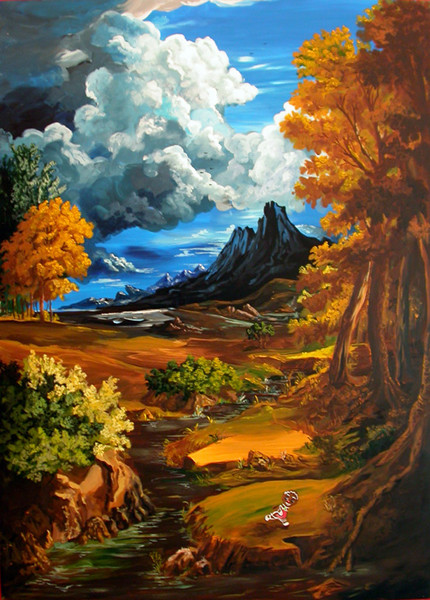Old School
27 Jun - 31 Aug 2007
OLD SCHOOL
Opening on June 27, Zwirner & Wirth will present an exhibition of paintings by Old Master and contemporary artists. Old School celebrates a re-engagement with Old Master modes of representation, which might be said to be a recent phenomenon in contemporary art. A younger generation of artists looks to the past in works that re-define and re-contextualize the techniques, themes, and imagery of their art-historical predecessors, and Old School aims to present a dialogue between old and new with a selection of works spanning the 15th to the 21st centuries.
Each of the younger artists in this exhibition presents a unique approach to history. By adopting the iconographies, graphic rhythms and techniques of Lucas Cranach, John Currin’s paintings from the mid to late nineties graft a historical complexity and painterly panache to the provocatively unnatural female bodies that feature in his paintings. Artists such as Currin, Anj Smith, and Djordje Ozbolt consciously make use of classic compositions of genre, history and landscape painting so that their images recall past artworks, while mining the gap between current sensibilities and those of previous times. This observance of different moments of time within a single image is also explored in Hilary Harkness’ complex paintings, which conflate episodes from history a contemporary extravagance, and in the works of Richard Wathen whose portraits are chilling distillations of all of a person’s ages into one.
While technical dexterity is a characteristic of many of the works in the exhibition, the attitudes displayed towards the art of the past vary tremendously. While some of the contemporary artists’ homages to old master work is spiked with ambivalence, the work of Berlinde de Bruyckere, in contrast, returns to timeless materials to treat age-old subject matters with warmth and sincerity. Moreover, Glenn Brown’s and Anj Smith’s superficial resemblances to old and iconic works give way to stylistic innovation.
In Old Master and contemporary works alike, theatricality and storytelling are fully-indulged. Allegories can be read and opinions pronounced through chance details and exaggerated and idealized forms. Sentimentality, humor and role-playing is evident in works such as Jakub Julian Ziolkowski’s Great Battle Under the Table and Julie Heffernan’s Self Portrait as a Tender Mercenary, while it is the dowdily-dressed people that inhabit Christopher Orr’s Brueghel-like landscapes that give his paintings their strangeness. Like Orr, Borremans, Peyton, Kilimnik, and Raedecker all weave grim and fabulous fairy-tales out of the conjoining of modern-day realities with elements and styles that point nostalgically to the past.
Opening on June 27, Zwirner & Wirth will present an exhibition of paintings by Old Master and contemporary artists. Old School celebrates a re-engagement with Old Master modes of representation, which might be said to be a recent phenomenon in contemporary art. A younger generation of artists looks to the past in works that re-define and re-contextualize the techniques, themes, and imagery of their art-historical predecessors, and Old School aims to present a dialogue between old and new with a selection of works spanning the 15th to the 21st centuries.
Each of the younger artists in this exhibition presents a unique approach to history. By adopting the iconographies, graphic rhythms and techniques of Lucas Cranach, John Currin’s paintings from the mid to late nineties graft a historical complexity and painterly panache to the provocatively unnatural female bodies that feature in his paintings. Artists such as Currin, Anj Smith, and Djordje Ozbolt consciously make use of classic compositions of genre, history and landscape painting so that their images recall past artworks, while mining the gap between current sensibilities and those of previous times. This observance of different moments of time within a single image is also explored in Hilary Harkness’ complex paintings, which conflate episodes from history a contemporary extravagance, and in the works of Richard Wathen whose portraits are chilling distillations of all of a person’s ages into one.
While technical dexterity is a characteristic of many of the works in the exhibition, the attitudes displayed towards the art of the past vary tremendously. While some of the contemporary artists’ homages to old master work is spiked with ambivalence, the work of Berlinde de Bruyckere, in contrast, returns to timeless materials to treat age-old subject matters with warmth and sincerity. Moreover, Glenn Brown’s and Anj Smith’s superficial resemblances to old and iconic works give way to stylistic innovation.
In Old Master and contemporary works alike, theatricality and storytelling are fully-indulged. Allegories can be read and opinions pronounced through chance details and exaggerated and idealized forms. Sentimentality, humor and role-playing is evident in works such as Jakub Julian Ziolkowski’s Great Battle Under the Table and Julie Heffernan’s Self Portrait as a Tender Mercenary, while it is the dowdily-dressed people that inhabit Christopher Orr’s Brueghel-like landscapes that give his paintings their strangeness. Like Orr, Borremans, Peyton, Kilimnik, and Raedecker all weave grim and fabulous fairy-tales out of the conjoining of modern-day realities with elements and styles that point nostalgically to the past.

